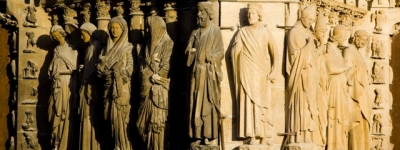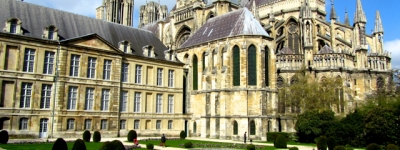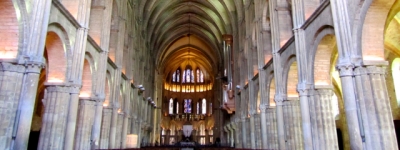History
History of Notre-Dame cathedral of Reims
Cathédrale Notre-Dame
Place du Cardinal Luçon, 51100 Reims
Website - tel : 03 26 47 55 34.
Free admission
Open daily: 7:30 a.m. to 7:30 p.m.
The present cathedral was not the only one to occupy this site. The first one, the Cathédrale de Saint Nicaise, dates back to the beginning of the 5th century, built on old Gallo-Roman baths. It was in this modest building, then measuring 55 meters long, that Clovis was baptized on December 25th around the year 498 by the bishop of the city: Rémi. Three centuries later, in the Carolingian era, Louis the Pious was the first monarch to be crowned there. In the 9th century the cathedral was rebuilt and named Cathédrale d’Ebbon et Hincmar, and in 862 it was consecrated by Charles the Bald. It became larger, at 86 meters long, and in the next century it was enlarged again to 110 meters. The first stone of the present cathedral was laid by Archbishop Alberic Humbert on May 6, 1211 following the destruction of the previous building by a fire. Much of the building was already built at the end of this century.
The towers would be added in the 15th century. The cathedral was then about 150 meters long, the nave rose to 38 meters and the two towers of the main facade, though lacking spires, rose to 82 meters. The dimensions of the Notre-Dame Cathedral of Reims are less impressive than other Gothic cathedrals of northern France from the same era, but the sensation of verticality, its towers reaching skyward that represent the heavenly Jerusalem, is still remarkable. The relative narrowness of the nave also accentuates this impression. The ubiquitous glass canopies and rosettes let in an abundant light, giving a feeling of lightness to the building that is found nowhere else.
Although it was a symbol of royalty and of royal power, the cathedral was relatively spared during the French Revolution of 1789. The first major restoration projects were conducted in the 18th century, and from the following century until today, restoration campaigns have continued, uninterrupted. In the 19th century, the major renovations were undertaken by Viollet-le-Duc (from 1860 onward). And on September 19, 1914 began the Martyrdom of the Cathedral (see below). In 1996, Pope John Paul II visited the cathedral on the occasion of the 1,500th anniversary of the baptism of Clovis by Saint Rémi. In May 2011, the city celebrated the 800th anniversary of the laying of the first foundation stone of the present cathedral.
"The Martyrdom of the Cathedral"
The cathedral was hit by the first German shells in September 1914, setting fire to the building. The frame was completely destroyed and 400 tons of lead from the roof melted and destroyed the gargoyles, as well as the archbishops’ residence: the Palais du Tau. The stone broke under the effect of heat, many statues were destroyed, and some collapsed. The Martyrdom of the Cathedral lasted another three years, hit by a total of 300 rounds. The rosettes and canopies exploded under the shock waves. At the end of the war, architect Henri Deneux would direct the reconstruction work with the invaluable help of generous donors, including American foundations (Rockefeller, Ford, etc.). The frame was replaced by a reinforced concrete structure to prevent future destruction by fire. The reconstruction and restoration are still ongoing.
Architecture
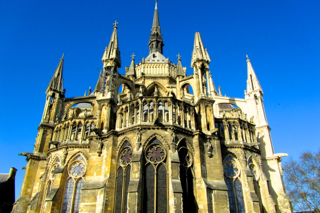
The cathedral is almost exclusively made of limestone from quarries located near Reims. We now know that the sculptures were painted in bright colors. The architecture of the cathedral is a masterpiece of Gothic art. Influenced by the early achievements of classical Gothic art of the second half of the 12th century, it represents the culmination of Gothic art in the 13th century.
Its exceptional facade dimensions, interior slenderness, narrow volumes and rich statuary are a major testimony of Gothic art. The combination of these different periods, concluded by the Gothic splendor of its towers, leaves an impression of stylistic unity, unique in Europe. The architecture of the cathedral benefitted from the technical progress of the 13th century but it is the combination of architecture and sculpture that makes this building so special. In fact, the sculptures aren’t just for decoration – they are part of the architectural construction of the building. For this it is a unique testimony to the technical capacity of builders and their ongoing commitment to beautification.
The jewel of the cathedral of Reims is without a doubt its sculpted ensemble. No other cathedral in Europe can compete with the richness and quality of the 2,300 statues of Reims. The technical and artistic influences that the builders used were based on existing workshops at the time : the antique workshop, influenced by Roman models, the Amiens workshop, heir to the construction of the Cathedral of Amiens and the Reims workshop characterized by the finesse, the striking expression and elegance of its sculptures. The corporal movement and facial expressions make them true artistic gems. The most striking being the “Ange au sourire” ("Smiling Angel"), which became the symbol of the city.
The iconographic message was primarily intended for those who were illiterate, whether believers or not, to glorify the Church. The baptism of Clovis, and more generally the divine dimension of the monarchy, were oft-repeated themes, thus justifying the universality of the message of the Church.
Visiting the exterior
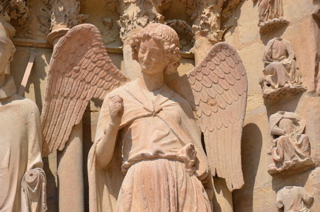
The facade
The facade of the cathedral is a masterpiece of High Gothic art, unique in the world in such proportions. It is best admired at the end of the day, when the setting sun enhances its relief and sculptures. The facade is highlighted in color at nightfall during the show “Rêve de couleurs” ("Dream of colors") from April to September, thus restoring the original bright colors.
Portals of the facade
The central portal is dedicated to Mary, and her figure is found on the trumeau in the center, holding the infant Jesus. Scenes from the Annunciation and the Visitation are depicted on the right, and the "Presentation of Jesus" to the left. Above the central portal is the "Coronation of the Virgin with Christ." Six angels are at their feet. This is a copy of an original work from the Palais du Tau. Still higher is the "Hall of Kings", composed of 56 large statues. In the center, Clovis is being baptized and by his side stand his wife Clotilde and Rémi.
The large statues of the central portal represent, to the right: the Angel of the Annunciation and the Virgin, the Virgin of the Visitation and her cousin Elizabeth, then King David and King Solomon. To the left, a servant (or the Virgin of Purification), the High Priest Simeon, Mary holding the Child to Simeon and Joseph. On the sides, Joseph, Isaiah and the Queen of Sheba. On the trumeau, the Virgin holding the baby Jesus. The moldings have undergone many changes over the centuries. One can distinguish the ancestors of the Virgin represented as kingly musicians, scenes of the earthly life of the Virgin, the manger of Bethlehem, prophets, saints and angels, as well as God and Christ.
The right portal is surmounted by the "Last Judgment." Christ is seated on his throne, accompanied by angels bearing the instruments of the passion. Scenes of the Apocalypse are represented in the arches. The conversion of Saint Paul is shown on the lintel under the small canopy.
The left portal and its arches are devoted to the "Passion of Christ". At the top of the portal you can see the crucified Christ. On the left splays, the beautiful "Smiling Angel" is visible. (1st figure to the left of the door).
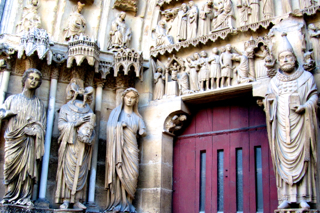
Portals to the north of the Transept
The central portal, called the Portal of Saints (1220-1230): the tympanum is beautifully carved. On the left: Saint Nicaise, beheaded by the Vandals in 407, brings his head to the altar as an offering to God. On the right Clovis is baptized by Saint Rémi. The tympanum is surmounted by Christ between two angels.
The left portal recounts scenes from the Last Judgment (1225-1230). The high quality of the sculptures reveal 13th-century artists’ perception of nudity and movement. Christ, at the top, is shown resurrected. He is surrounded by the Virgin, Saint John the Baptist and two angels bearing instruments of the Passion. The scenes of the Last Judgment are recognizable by images of the dead coming out of their graves to be judged, by the virtues and vices expressed below, and by foolish or wise virgins in the arches.
The right portal, in Romanesque style (1160 - 1170). The Romanesque portal was integrated into the gallery of the cloister of the canons until the 18th century.
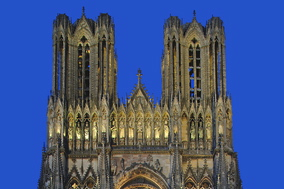
The Cathedral Towers
Cathdrale de Reims, 2 Place du Cardinal Luçon, 51100 Reims
Website - tel : 03 26 47 81 79.
Full price / reduced price: €8 / €6.50. Free for EU citizens under 26 years old, of non-EU citizens under 18 years old.
Combined ticket for the Cathedral towers and the Palais du Tau : Full price / reduced price: €11 / €8. Free for EU citizens under 26 years old, of non-EU citizens under 18 years old.
Opening dates for visits :
Mid-March, April, September and October, on Saturdays and Sundays.
May through August, every day except Monday.
The towers are closed from November to mid-March.
Visiting the interior
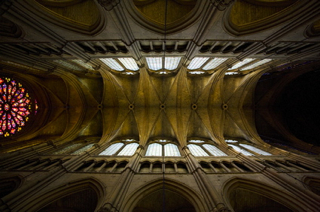
Interior architecture
Upon entering the cathedral, the clarity and the slenderness of the arch are accentuated by its length and narrow volumes. The nave has a three-level rise, in a classic French Gothic style of the 13th century, a style already used in Chartres. The chapels are adorned with a multitude of angels, in an elegant and innovative style for the time.

The interior of the western facade
The other side of the facade is decorated in a style found nowhere else. The artistic quality of the sculptures in the niches is exceptional. Adorned with 52 figures and interspersed with plants, this carved wall composed of episodes from the life of Mary and John the Baptist was meant to be seen by the king as he came out of the cathedral after the ceremony of his coronation.
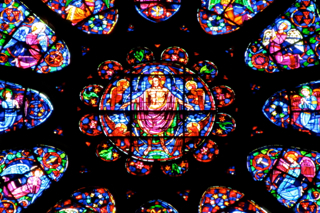
The stained glass windows
Gothic cathedral windows have suffered greatly over the centuries, but there are still some fine examples of the original pieces from the 13th century, mainly grouped in the upper parts. For the others, some were restored by workshops from Champagne, and others were replaced with white glass. Following World War I and the damage caused to these works of art, new, contemporary stained glass took place in the cathedral. Of note in particular are the three windows of the axial chapel designed by Marc Chagall in 1974. More recently, the windows designed by German artist Imi Knoeble and produced by the Simon Marq workshop were inaugurated in 2012.
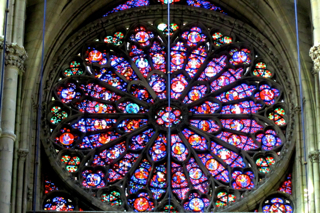
Medieval stained glass windows
Grand rosette of the west facade (13th century). This Gothic rosette of high technical and artistic quality in the shape of a flower with twelve petals represents the Assumption. Its center features the Dormition of the Virgin surrounded by the 12 Apostles depicted as haloed angel musicians.
High windows of the choir (12th century). The windows express the power of the Church of Reims. Two processions can be seen : one accompanies the Archbishop of Reims, the other is composed of the Apostles accompanied the Virgin and Christ.
Grand rosette of the north facade, "Creation" (13th century). At the center of the rosette, God the Creator is surrounded by the sun and the moon. The compartments reflect scenes from the life of Adam and Eve in Paradise, and Cain and Abel after the original sin.
Stained glass windows of the nave (14th century). Initially composed of 36 kings and archbishops, 16 have survived the different episodes of history.
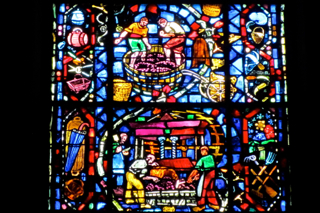
Contemporary stained glass windows
Small rosette of the west façade. The work of master glassmaker Jacques Simon in 1937, entitled "Litanies of the Virgin."
Grand rosette of the south transept. The existing windows, created by Jacques Simon in 1937, largely in line with the iconography established in the 13th century. The window features Christ crowning the Virgin, the 12 Apostles and the instruments of the Passion presented by an angel. In the center, the risen Christ shows his wounds. The symbols of the four evangelists (ox, lion, eagle and winged man, with a half-open book) are situated around him.
"Stained Glass of Champagne" or wineries, in the arch of the south transept below the grand rosette. They were commissioned in 1954 by "the Corporation des vins de Champagne" to Jacques Simon. The different trades are represented around Saint Vincent (patron saint of winemakers), Dom Pérignon (the father of champagne) and Saint John the Baptist.
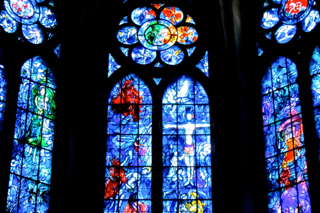
The stained glass windows by Marc Chagall
In 1974, Marc Chagall (1887-1985) created three windows for the axial chapel of the cathedral in collaboration with the Jacques Simon and Charles Marq workshop.
The iconographic program of Marc Chagall: the first window features the theme of the Tree of Jesse, the central window depicts both testaments (Sacrifice of Abraham and the Sacrifice of the Cross) and the right window tells the history of Reims (baptism of Clovis and the coronation of Louis IX). The artist managed to combine modernity and respect the existing tones of the medieval stained glass windows, from which he borrowed blue tones to preserve the harmony of colors.
“Eau Vive” of the south transept (1961). In the south transept, Brigitte Simon-Marq (daughter of Jacques Simon) created an abstract canopy entitled “Eau Vive” ("Flowing Water").

